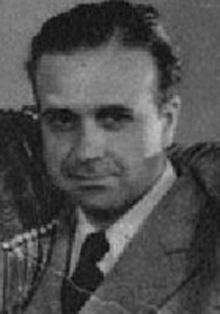Related Research Articles

Castillo San Cristóbal is a fortress in San Juan, Puerto Rico. It was built by the Spanish to protect against land-based attacks on the historic city of Old San Juan. It is part of San Juan National Historic Site.
René Muñoz was a Cuban actor and screenwriter of telenovelas and the cinema of Mexico.

Carlos Francisco Borcosque Sánchez was a Chilean film director and screenwriter involved in the production of the Cinema of Argentina.

Luis César Amadori was an Italian-Argentine film director and screenwriter and one of the most influential directors in the cinema of Argentina of the classic era. He directed over 60 films between 1936 and 1967, writing the scripts to over 50 pictures.

Carlos Rinaldi was an Argentine film director, film editor and screenwriter.
K-Paz de la Sierra is a regional Mexican band that was formed in Chicago, Illinois, United States. The band specializes in the Duranguense genre.

Urabá Antioquia is a subregion in the Colombian Department of Antioquia that consists of two enclaves, one forming the northwest corner of the department the other, the west, both are along the Atrato River and are separated by the El Carmen del Darién and Riosucio municipalities of the Chocó Department with territories in both municipalities in dispute with Chocó. The region is made up by 11 municipalities. Most of this region's northern portion is part of the Colombian Caribbean Region bordering the Caribbean Sea.
Fuerte San Francisco is a football club based in San Francisco Gotera, El Salvador that plays in the Primera División, the top flight of Salvadoran football. Nicknamed Los Comandos Azules, the club has won two league second division titles, Seven third divisions titles and one promotional titles.
Cruz Diablo is a 1934 Mexican film directed by Fernando de Fuentes. The New York Times called it "one of the best films that ever crossed the Rio Grande".

The Fortaleza de Santa Teresa, or Fortaleza Santa Tereza is a military fortification located 36 km (22 mi) south of Chuy and 305 km (190 mi) northeast of Montevideo on Route 9, in the Rocha Department of eastern Uruguay. It lies about 800 m (2,600 ft) from the coast at Playa la Moza, almost halfway between Angostura and La Coronilla , north of Punta del Diablo and roughly 4 km (2.5 mi) northeast of the northeast bank of the Laguna Negra. It lies within the Santa Teresa National Park. It was erected from October 1762 by the Portuguese, having abandoned the attempt at building a fort in Maldonado and leaving the Fuerte San Miguel.
Events of 2012 in Spain.
Mexican sex comedies are films within the comedy film genre of the Mexican cinema industry, though in a class of their own. The storylines typically revolve around themes of sexploitation and "Mexploitation". They are mostly recognized as low-quality films with fairly low budgets. The genre peaked in popularity in the 1970s and 1980s. Although the films had sexually suggestive plots and used numerous comedic innuendos and double entendres, they were not overtly explicit, and were never considered to be pornographic. Furthermore, it was not uncommon for the male characters in these films to comedically fail in their attempts to win over, or have sex with, the female characters. When a man was successful in wooing a woman, the performances were deliberately over-exaggerated and pantomime-like, aiming to generate laughter more than arousal. The genre is similar to, and possibly influenced by, Italian erotic comedies. The popular term "ficheras films" came from the film Las ficheras, produced and released in 1975, which told the stories and experiences of many dancing women who entertained men at nightclubs.

Emperatriz Carvajal was a Chilean actress and singer who worked extensively in Argentina and Mexico.

Gerardo Ortiz is an American singer in the regional Mexican genre.
Events in the year 1962 in Spain.

Alma Rosa Aguirre Juárez is a Mexican actress.
Devil's Roundup is a 1952 Spanish drama film directed by Antonio del Amo, Enrique Gómez, Edgar Neville, José Antonio Nieves Conde and Arturo Ruiz Castillo.
The Devil Plays the Flute is a 1953 Spanish comedy film directed by José María Forqué and starring José Luis Ozores, Luis Prendes and Luis Arroyo.

Sniper: Ultimate Kill is a 2017 American action film directed by Claudio Fäh and starring Chad Michael Collins, Billy Zane, and Tom Berenger. The film is the seventh installment of the Sniper film series and a sequel to Sniper: Ghost Shooter (2016). It was released direct-to-video on October 3, 2017.

Fuerte perdido or Asalto a fuerte apache is a 1965 Spanish western film directed by José María Elorrieta and starred by Germán Cobos, Mariano Vidal and Marta May. The story was written by Fred Uratia.
References
- ↑ Plazaola, Luis Trelles (1 January 1989). South American Cinema/ Cine De America Del Sur: Dictionary of Film Makers/ Diccionario De Los Productores De Peliculas. La Editorial, UPR. p. 36. ISBN 978-0-8477-2011-8.